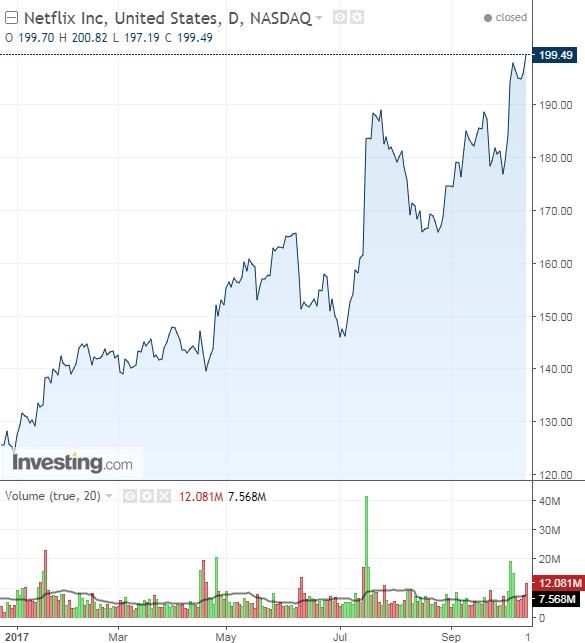by Clement Thibault
Netflix (NASDAQ:NFLX), the global streaming video service, reports Q3 2017 earnings on Monday, October 16 after US markets close. Consensus expectations are that Netflix will report $0.32 EPS on revenue of $2.97B.

1. Price Hike
On Thursday, October 5, Netflix announced it was raising prices for its streaming video services in the US. The monthly price for a new subscriber was raised by $1 to $10.99, while the premium plan—which allows four simultaneous connections—now costs $13.99, $2 more than previously.
Netflix's US price hike shouldn't come as a surprise. Last quarter our analysis reviewed Netflix's spending and revenues and we concluded that:
"Netflix will have to raise the price of its services going forward."
We weren't wrong, both in our prediction and insofar as the importance of the hike. It's a necessity.
With about $15 billion in content obligations but just $10.2 billion in revenue TTM, and only $362 million in profit for a net profit margin of just over 3.5% , there was simply no way for Netflix to keep its prices so low for so long.
Netflix's pricing scheme appears to be a variation of that often used sales approach, just get your foot in the door. Th tactic is simple, even cliched—get the potential customer to ultimately sign on for a large transaction by first setting them up via a modest deal. The lower initial price smooths the way for a bigger future sale at a higher price.
The company also banks on the free trial effect, although in this case the trial isn't actually free; rather it's a short-term reduced rate. Once the consumer gets a taste of the service, they realize how good the product is and gladly sign on to continue at the full cost. Netflix's product is indeed appealing to most US households, which has made both these methods highly successful for the company.
We believe the combined affects are an excellent strategy for Netflix. A satisfied customer at $9.99 is likely to remain a happy customer at $10.99. Most people will dismiss the price hike by saying "it's just one dollar per month." Few are likely to focus on the 10% increase in the service's price.
Still, raising prices can be a double edged sword.
Netflix's stock price remains entirely dependent on its net subscription adds during the quarter, both domestically and internationally. Last quarter, Netflix grew by 5.2 million global subscribers against a forecast of 3.2 million, which sent the stock price up 13% on the report.
However, continually raising prices is not the best way to recruit new customers. At this point, Netflix is probably satisfied by its penetration in the US market —about 44% of US households subscribe—and we expect CEO Reed Hastings to begin downplaying subscriber growth during the analyst call following tonight's earnings results.
As for future price hikes, the most recent boost wasn't international, although it's pretty clear that one will follow. The US domestic market is also likely to see another price hike in 2018. Netflix's $13 billion in balance sheet liabilities plus $15 billion in content obligations clamors for it.
2. Competition
Not surprisingly, the competition is pushing back in a big way. Hulu, the subscription video-on-demand service that's a joint venture with Disney (NYSE:DIS), 21st Century Fox (NASDAQ:FOX), Comcast (NASDAQ:CMCSA) (via NBCUniversal), and Time Warner (NYSE:TWX) (via Turner Broadcasting), is one of Netflix's fiercest rivals. It dropped its entry-level monthly membership fee from $7.99 to $5.99. Amazon (NASDAQ:AMZN) is staying put at $10.99 for now, but continues to offer a free subscription with Amazon Prime.
Netflix's price increase alongside Hulu's price reduction creates a perfect petri dish from which to discern consumer preferences. How price-sensitive are consumers within the current content streaming environment?
If the growth of Netflix's US subscriber base doesn't significantly slow or shrink, and Hulu's customer base doesn't grow in any appreciable way, it would be reasonable to assume Netflix has a certain amount of pricing power, something that's of paramount importance both to the business and its investors. However, if Netflix's fee increase affects growth in a significant manner and at the same time Hulu manages to strongly grow its customer appeal, it will become clear that Netflix is vulnerable to competition.
Amazon is pouring additional resources into content, and after Hulu's The Handmaid's Tale swept the top dramatic honors at this year's Emmys, Hulu has revealed itself to be a serious contender in the quality content arena. As well, Apple (NASDAQ:AAPL) and Facebook (NASDAQ:FB) are looking to enter the industry too.
Netflix spends about $7 billion a year on content. Amazon isn't far behind with its $6 billion outlay. Hulu currently trails with $2.5 billion in annual content expenses, while Apple and Facebook will each begin testing the waters with $1 billion worth of new content efforts apiece.
All this just goes to underscore the need for Netflix to increase prices yet more. Without additional subscription revenue the company will not be able to fulfill its obligations, not to mention create profit for shareholders. From the get-go, Netflix has bet that significant spending will separate it from the pack and allow it to incrementally raise prices. We're waiting to see what the future brings: whether proof of pricing power, or signs of big, big trouble ahead.
Netflix stock price just touching $200 tells us that Wall Street remains optimistic about the company going forward. As we mentioned in our last post about the company (link above), it will take a minimum of two years at the very least to justify the current price point.
If subscriber numbers hit or exceed, Netflix might be good for a quick profit, but we don't see this as a smart entry point for a longer term investment.
